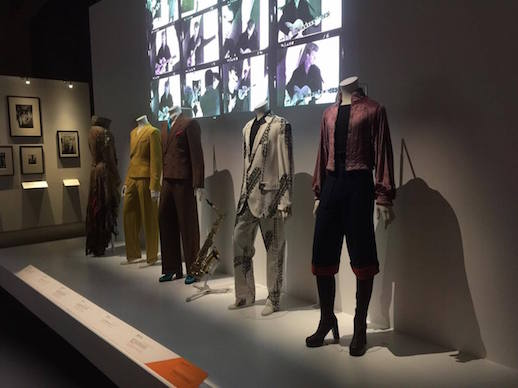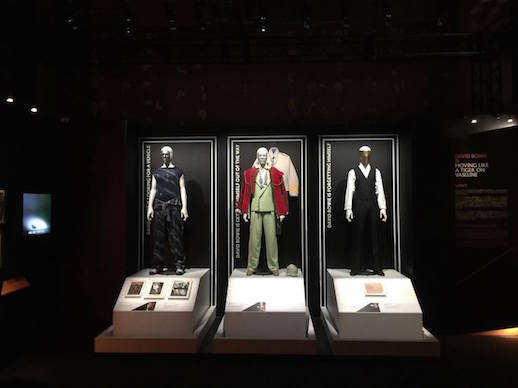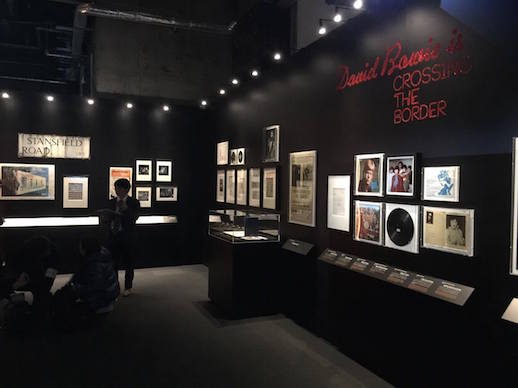David Bowie is

“David Bowie is” at Terrada Warehouse presents an enjoyable look at the inimitable life of David Bowie, someone who has shaped culture around us today. His music, style, collaborations and films – not to mention countless covers and variations of his work – have left a Bowie-shaped hole in the universe that cannot be filled.
Bowie is made accessible even to those with limited to no prior knowledge of him: Sections called “areas” document the various periods of his career, his alter egos, collaborations, and influences. These spaces are vaguely chronological, providing an overview of Bowie’s interests and influences from diverse cultures over the years. The entrance puts you face to face with Bowie’s collaboration with legendary Japanese designer Kansai Yamamoto, quickly establishing the mood of the exhibition and affirming Bowie’s interest in Japanese culture, a theme prevalent throughout his career.
Bowie’s early attempts with numerous bands introduce his style and work ethic: An initial period of struggle and band-hopping anticipates what is to come. The social climate in London during the early 1960s is also clearly an influence on young Bowie, from the first live sessions by the Beatles (1962) and the debut of the Rolling Stones, to the culture (and mostly negative media attention) surrounding “Mods & Rockers.”
Don’t miss amazingly well-preserved collections of Bowie’s alter-ego costumes modeled on mannequins. Collaborations with notable (and lesser-known) designers such as Alexander McQueen (Union Jack jacket), Freddie Burette (Life on Mars), and Kansai Yamamoto early on in their careers while they were still budding designers demonstrates Bowie’s unique taste and sharp eye for talent.

Films, in particular science fiction, are also recognized among Bowie’s influences. Consider the lavish silver tones of Doctor Who (launched at around the time of Bowie’s experimental period), or the faint hints of Star Trek with dashes of Godard’s Alphaville and Fritz Lang’s Metropolis to be observed in Bowie’s work. Space Oddity put Bowie on the map and introduced the world his eclectic style, with early Stanley Kubrick to be a major influence on Bowie’s visual style, characters, and other work to come.
Bowie not only created alter egos with backstories, but also universes for them to live in, sampling from various trends in the cultural landscape of the 1960s and 1970s. His music videos played a huge part in the development of his self-created culture and reinforced the conceptual approaches he took to his albums. His set and costume designs were often shaped by the aforementioned films and media. Original materials and displays showing these influences are aptly presented alongside Bowie’s work and original notes.
It is no surprise that Bowie became a formidable actor, playing characters in films that have become cult and art house classics. The Goblin King in Labyrinth (1986), Andy Warhol in Basquiat (1996) (was it David playing Andy or Andy playing David?), and Nikola Tesla in The Prestige (2006) come to mind as memorable characters that show his breadth as an actor. Bowie has been known to say he despised acting compared to his parallel career as a musician, but he left an impact on the industry nevertheless. He was clearly a man of collaboration, and his contributions remain influential today.

“Bowie Meets Japan” highlights in the exhibition include his work with the aforementioned Kansai Yamamoto, whose costume designs helped shaped the Ziggy Stardust persona. Yamamoto was initially unaware of Bowie wearing his clothes, but the two eventually forged a long relationship when they realized they were on the same wave-length. Furthermore, Bowie’s performances have been said to associate with Japanese Kabuki theatre, in particular onnagata, a dramatic role in which men perform as women and apply their makeup in a particular fashion. The influence can be clearly seen in Bowie’s androgynous features and in the personas of his characters. Photographer Masatoshi Sukita also has served as Bowie’s portraitist and long-time collaborator for three of his albums, the most well-known being Heroes (1977).
The exhibition’s organization and loosely chronological presentation of Bowie’s work succeeds. The scope of his exploration, progression, and in particular his collaborations, is an enormous undertaking spanning the five-plus decades of his career. This show is a significant tribute to Bowie’s life and work, and fans should be pleased to see such an intimate perspective on his ideas and creativity. David Bowie will surely live on and continue to influence artists of this and subsequent generations.
Simon DeBoer
Simon DeBoer


